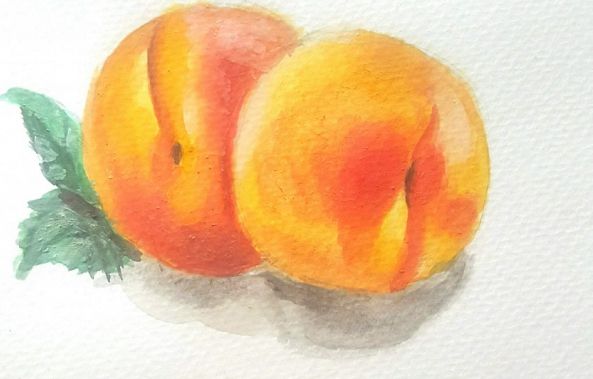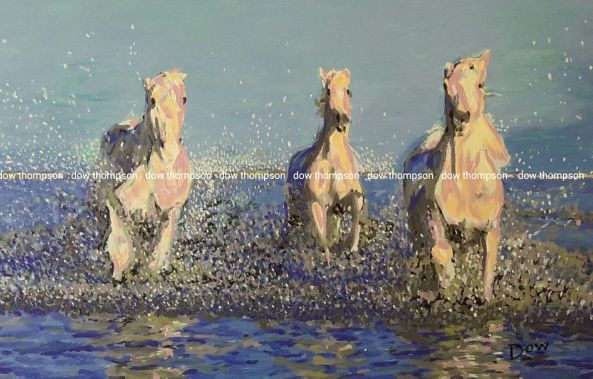Impressionism
The emergence of Impressionism can be traced to the period before the industrial age and through the 19th century. Impressionism time period was such that offered a totally new style of painting. Impressionism is an art form that shows light and changes of time in an almost accurate way while creating images with consideration for movement. The introduction of impressionist art began in France by artists who resided in Paris at the time. Impressionism at the time was considered an unusual form of painting as it was radically different in style and technique from what was previously obtainable.
Impressionism art definition can be explained as the creation of an object or scene in the absence of any visible representation. In much simpler terms, impressionism is an art form that does not pay attention to the detail of images but creates a strong and vivid impression that is just like what you would remember after looking at a scene or landscape. The minds that conceptualized impressionism art were students under the tutelage of Charles Gleyre. Owing to their dissatisfaction with religious and mythological paintings they banded together to pursue their fascination with landscape painting and paintings of modern day life scenes.

Image via https://www.metmuseum.org
Some of what influenced impressionism is the love for a livelier art form. More than any other theme, impressionism art became known for depicting landscapes and sceneries in the most captivating way. Also, impressionism art was used to capture scenes as well. Impressionist art could adequately depict light and the details of the outside environment with a remarkable level of accuracy. As opposed to still-life and portraits, the emergence of impressionism art saw the creation of what could be described as fresh art.
While impressionism art faced resistance in the beginning, people soon began to appreciate the incredible accuracy with which impressions of the eye is captured in the painting. The acceptance of impressionism soon led to the emergence of a variety of other painting styles that deemphasized the outlining of images. Art forms like Post-Impressionism, Fauvism, and Cubism owe their emergence to impressionism art.
Impressionist techniques

Image via https://www.metmuseum.org
One thing that was crucial to the creation of impressionistic artworks is the use of light brush strokes. It is nearly impossible to create an impressionist painting without mastery of using faint brush strokes. Impressionism art is such that does not pay attention to the creation of images as a result, the use of light brush strokes is an integral part of creating impressionist art. The technique is such that does not show clear and visible lines. Instead, it adopts the light brushing of vivid pigments that come in single and combined colors. The result of this style of art is the ability to create works that show the impression of what is seen by the eye and recollected from memory.
The technique of impressionism art also focused on outdoor environments and landscapes as opposed to portraits. Ultimately, the technique was able to capture the vivid impression of sunlight while focusing on modern subjects and scenes. Impressionism art characteristics creates a uniquely different form of art that communicates sensation.
The goal of impressionism artwork is to create an impression and sensation. This is achieved by creating a scene that deemphasizes images but communicates a sensation. Abstract impressionism is one of the products of impressionism. Abstract impressionism art characteristics are such that shows impulse and the unrestrained expression of energy. Abstract impressionism does not show any images but combines colors in a skillful way that evokes strong feelings and sensations. Developed in the 1940’s, this form of painting is such that doesn’t feature any discernable object but intricately combines a wide range of colors to conjure string feelings.
How did Impressionism start

Image via https://commons.wikimedia.org
The beginning of impressionism art is found within the context of rebellion from the authorized and orthodox style of painting which was certified by the Académie des Beaux-Arts, an institution that was the custodian of French painting style. Traditionally, French painting was in the form of portraits, mythological and religious themes. While this approach of painting had been the norm for many years, a band of young artists who were unhappy with the somewhat unexciting nature of this painting style decided to explore a different approach to painting. As opposed to the traditional painting style which was done in the studio, these painters decided to paint out in the open.
In the wake of the 1860’s a group of young artists soon realized that they were intrigued by the same style of painting. Claude Monet, Pierre-Auguste Renoir, Alfred Sisley, and Frédéric Bazille who were under the tutelage of Charles Gleyre were much more intrigued by landscape paintings and creating scenes from modern life. This fascination was not in line with the orthodox painting style in France at the time. Their approach to executing this style of painting was equally unorthodox as they would make the sketches in the open environment while creating blueprints that will be completed in the studio. Given that they creating the sketches in the open, coupled with the availability of bright artificial colors that were produced at the time, they were able to create paintings with an intricate blend of vivid colors. These artists often converged at Café Guerbois and the meetings were frequently coordinated by Édouard Manet.

Image via https://commons.wikimedia.org
When exploring the history of Impressionism, one of its earliest artworks is Édouard Manet’s The Luncheon on the Grass. Artworks of every artist in France was vetted by the Salon jury and the four father’s works were regularly rebuffed on the premise that they did not paint in alignment with existing and authorized French painting style. Édouard Manet, The Luncheon on the Grass is one painting that was rejected by the Salon Jury on the premise that it featured a nude lady. It is worth mentioning that there were many mythological paintings that featured nude women however the sight of a nude woman and two well-dressed men in a modern setting seemed to be revolting to the Salon Jury.
However, this matter would not go away silently. Many lovers of this art were discontent with the vitriolic condemnation it received from the Salon Jury. More so, many lovers of art, as well as professional artists, were discontent at the fact that many works of art which they considered exceptional were rebuffed by the Salon Jury. Following rejected appeals to disband the existing Salon Jury in 1867 and 1872, a group of artists decided to come together and showcase their works autonomously.

Image via http://www.aurlaea.com
Monet, Renoir, Pissarro, Sisley, Cézanne, Berthe Morisot, and Edgar Degas together with many active painters at the time, unified to create what they called the Cooperative and Anonymous Association of Painters, Sculptors, and Engravers. Those that were part of this newly found union were to renounce their membership of the Salon jury. By 1874, this union had its foremost exhibition which featured the works of 30 artists. The feedback from the public was a blend of good and bad. However, Monet and Cezanne were the ones who got the hottest criticism. The publication at the Monet’s painting was explained as a mere sketch in the tabloids by Louis Leroy who happens to be a comedian.
Over time, impressionism artists began to generate a lot of monetary gains from their artworks. In like manner, their style of painting soon began to be widely appreciated and accepted. Monet and most of his colleagues had made significant monetary success from their art form. Also, impressionism art at the time had become an accepted and preferred style of painting at the Salon.
Representative Artists
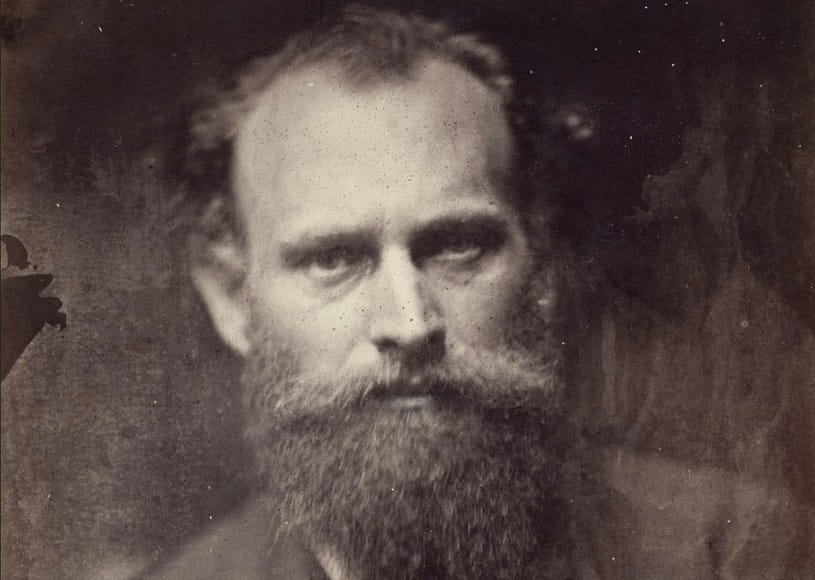
Image via http://1.bp.blogspot.com/
Representational art refers to the abandonment of clear-cut imagery for the use of signs in the depiction of real-life circumstances and ideas. When you stare at a representative art, you can almost grasp what the artist is trying to communicate and this idea is relatable to real life events and circumstances. However, the artist uses signs to communicate this through the use of different elements. Essentially, representative art is a figurative art that communicates ideas and events with the use of elements that are otherwise unrelated but evocative of that idea.
Romanticism, Impressionism, and Expressionism are some of the products of representative art. Examples of representative art are Claude Monet’s woman with Parasol, Haystacks, water lily ponds, and many more. One of the fathers and most prominent names in the world of representative painting or impressionism art is Claude Monet.

Image via Claude https://www.christies.com/
Understanding the distinction between realism and impressionism may be challenging for some because of the similarities between the two styles of painting. However, realism vs impressionism can be demystified by understanding the underlying philosophy that separates both art forms. Impressionism is created to evoke a sensation and evoke an emotion. Given the aforesaid, it becomes expected that impressionism art is only a magnified recollection of how a particular scene is seen. While both impressionism and realism capture modern daily life, the core distinction between the two is hinged on the fact that one is created to evoke a sensation or feeling while the other depicts scenes and events just the way they are. While impressionism has a touch of glamor and sensationalism, Realism would portray scenes in the exact way they are no matter how lackluster.
Some of the impressionism artist that stood out throughout history for their contributions to the development of impressionism art form and their creations includes Claude Monet, Pierre-Auguste Renoir, Edgar Degas, Paul Cézanne, Édouard Manet and many more. Given that impressionism painting emerged in France, it can be said that Oscar Claude Monet is the father of impressionism as he is recorded as the one to introduce impressionism painting in France. Monet produced some of the most fascinating impressionism artworks which include his water lily collection.

Image via https://www.christies.com
The introduction of the first set of impressionism paintings was in the exhibition of 1874 following Monet’s decision to leave the Salon de Paris. Vincent Van Gogh’s place in the history of impressionism art is reinforced by the fact that he championed impressionism art in the Netherlands. Vincent created a ridiculously significant amount of paintings in his lifetime. Coming from a comfortable family, he was described as pensive as a child. His paintings encompassed, portraits, landscapes and still life which were often created using the impressionist art technique. While he was plagued with dementia, he created many of what is considered the most impressive impressionist artworks.
Some of his best works include Bedroom in Arles in 1888, The Potato Eaters in 1885, Self-Portrait with Bandaged Ear in 1889, Sunflowers in 1888 and much more. The astounding quality of Pierre-Auguste Renoir’s impressionist artworks made many admire this art style. Known for his love of women’s beauty, most of his works were reflective of his passion. Some of his most impressive works includes Two Sisters (1881), The Umbrellas (1886), La Parisienne (1874), Young Girls at the Piano (1892), Madame Georges Charpentier and Her Children (1878), Dance at Bougival (1883), La Loge (1874), and Les Grandes Baigneuses (1887).

Image via https://en.wikipedia.org/
Pierre Auguste was known for creating many woman nudes. Edgar Degas is an impressionist artist that was born on 19 July 1834, Paris, France. This artist is known for his fascination with dance and this led to this creation of many artworks that were centered on dance. The history of French impressionism painting would be incomplete without mentioning his name. His best works include The Absinthe Drinker, The Dance Class, Interior, Ballet Rehearsal on Stage, A Cotton Office in New Orleans, and The Millinery Shop. Paul Cézanne is also amongst the long list of French impressionism painters.
However, he stands out for introducing a new style of impressionism painting that encouraged the emergence of many new forms of painting. His unique approach to painting is said to have inspired many other artists. His most celebrated works remain the Boy in the Red Vest in 1890, L'Estaque, Melting Snow in 1871, Portrait of Madame Cézanne with Loosened Hair from 1890 to 1892, The Basket of Apples in 1895 and The Bathers. Édouard Manet is one French artist that is celebrated for his painting of modern life. His most celebrated works include the controversial Le Déjeuner sur l'herbe, Olympia, Alabama and Kearsarge, Boating, and A Bar at the Folies-Bergere. While there are many more prominent names of impressionist artists, Alfred Sisley, Mary Cassatt, Camille Pissarro, Henri Matisse, Berthe Morisot are artists names that contribute immensely to this art form.
Most famous artworks
By the time impressionism art became widely popular, there were many artists that were inspired to create masterworks that could be described as the best impressionist paintings. While there are many astounding impressionism paintings, only a few fits in the category of being famous.
Water Lilies (1906 - 1915)

Image via Image via http://lafittemusiccenter.com
By the father of impressionism art Claude Monet who fell in love with water lilies after purchasing a house in the countryside with plenty lilies around its surroundings. His fascination led to the creation of many astounding paintings using oil paint. With an incredible blend of fantastic colors, he created an enchanting water lily series.
Bal du Moulin de la Galette (1876)

Image via http://www.renoir.net
The dance by Galette is a painting that was created in 1876 by Pierre-Auguste Renoir, this painting is one of the most celebrated impressionism paintings ever created. Interestingly, this painting is a mirror a usual Sunday afternoon at Moulin de la Galette in the area of Montmartre. This painting evokes a friendly and jovial atmosphere that is filled with laughter and fun. People dancing in the rear while others making merry conversation at the forefront.
A Bar at the Folies-Bergère(1882)

Image via http://www.manet.org
This stunning painting by Edouard Manet shows a modern bar scene and a lady who is standing behind a table that I adorned with fine wine and fruits. The interpretation of this painting has engendered many debates by experts over the decades. Some argue that the lady in the pictures is a prostitute. Some argue that she is a commodity just like the rest of the items while others claim that the lady is just a high-class bartender.
Impression, Sunrise by Claude Monet (1872)

Image via https://arthistoryproject.com
Created by Claude Monet, this painting features the rising sun in classic impressionism art. The painting was created using traditional impressionism style with light brush strokes and a blend of vivid colors to give an impression. When trying to grasp the concept of impressionism art, Impression, Sunrise is undoubtedly a perfect reflection of what impressionism painting is all about.
The Luncheon on the Grass by Edouard Manet 1862 -1863
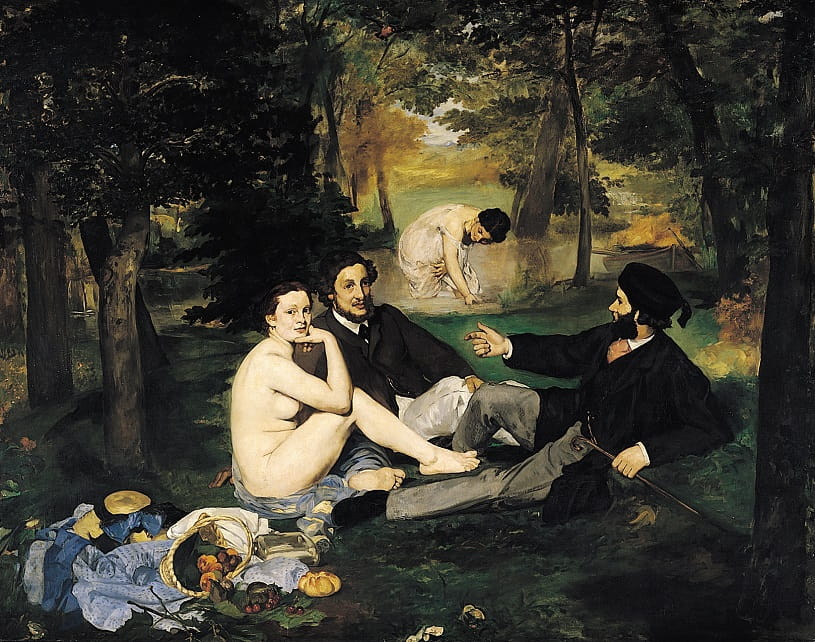
Image via https://fr.wikipedia.org
This painting was created by Edouard Manet and displays naked women sitting on the grass with two fully dressed men. While these three characters make up the center of the painting, a lady in a stream can be seen in the rear. The painting is such that has received a lot of interpretation over the years. Of note is the way in which the woman is staring at the audience in a suggestive way. This painting was rejected by the Salon Paris on the grounds of nudity. Many other critics were also worried about the men being properly dressed and the woman being naked. This painting showed the natural surroundings in its splendor.
Paris Street; Rainy Day (1877)

Imag via http://www.galleryintell.com/
Created by Gustave Caillebotte in 1877, this painting features a rainy day in the Paris. Just like any other impressionist painting, the work of art evokes an atmosphere that is consistent with the average rainy day. However, this painting captures life in 19th century Paris. This painter was able to create a shadowy impression with an indicate mastery of light for heightened sensation. His impressionism art style is such that resembles actual photographs. The use of perspective for depth and the depiction of an outdoor environment with stunning accuracy are some of the features of Caillebotte’s painting that made him stand out.
Luncheon of the Boating Party by Pierre-Auguste Renoir 1881
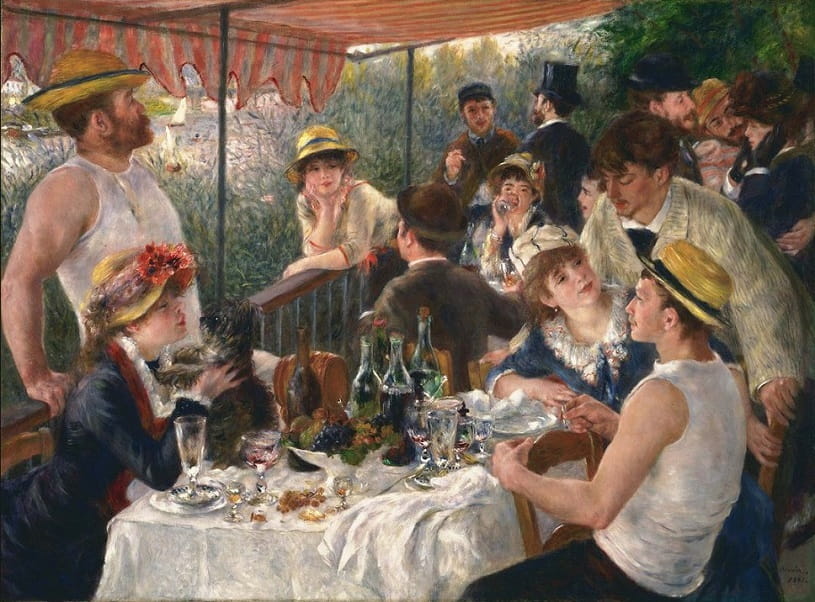
Image via http://www.renoir.net
The Luncheon boating party was created by Pierre-Auguste Renoir in classic impressionism style. The painting is such that is evocative of a delightful party. This painting features brushing in light strokes, however, the painting is such that is captures people with amorous stares of bliss. Known for his ability to capture women and their beauty while evoking female sensuality, this artist many incredible nudes.
Pont Boieldieu in Rouen, Rainy Weather Camille Pissarro 1896

Image via https://commons.wikimedia.org/
Created by Camille Pissarro in 1896, this landscape painting could be described as a masterpiece. This Danish and French artist created many incredible landscape paintings with impressionism style. Most of his outdoor paintings were remarkable and included Jalais Hill, Pontoise (1867), The Crystal Palace (1871), Self-Portrait (1873) and many more. Pisarro engaged in a series of paintings of bridges and this one happens to be one of his best. The painting showed a rainy day on a bridge and captured most of what is the contemporary era at the time. Pissarro's painting of the outdoor environment was remarkable and often featured people going about in their various activities.
The Absinthe Drinker by Edgar Degas 1876

Image via https://en.wikipedia.org
Created by Edgar Degas in 1876, this impressionist painter has a reputation for painting dancers. As a result, it can be asserted that Edgar is great at depicting motion in a way that is vivid. As an impressionist artist, most of his works come in light brush strokes and vivid colors. Equally known for creating nudes, Edgar Degas created many impressive works of art with the Absinthe drinker being the most famous of his works.
The floor scrapers by Gustave Caillebotte 1875

Image via http://vangoghpaintings.com/
The Floor scrapers is an impressionist painting that was created by Gustave Caillebotte in the year 1875. Gustave Caillebotte belonged to the group of artists that were regarded as an impressionist. However, his style of impressionist positing was borderline realism. His style of painting and the technique he adopted was crucial in the creation of The Floor Scrapers which is regarded as one of his most brilliant works. In line with the idea of impressionism art, this painting is such that features people scraping the floor of what could be described as a yoga or ballet studio. Given his fascination with photography, his own form of impressionism as seen the case of the Floor scraper is sometimes considered to incorporate some elements of realism particularly when the accuracy of the painting is considered. Given the aforesaid, Gustavo had admirers of his artwork who weren’t lovers of impressionism as he often paid attention to detail in his execution.
Impressionism in other countries
While impressionism had its roots in France, it soon spread to many other countries where it evolved significantly. Some of the many products of impressionism art are post-impressionism, cubism, abstract impressionism, realism, expressionism and more. American impressionism began in the 19th century and featured classic European impressionism style. With light brush technique and bright colors, many American artists were able to create a sensational painting without paying attention to detail. William Merritt Chase, Childe Hassam, and Frederick Carl Frieseke were some of the many names in American impressionism art. Impressionism art spread throughout Europe with an extensive variety of distinctive styles that apply the same technique of impressionism.






